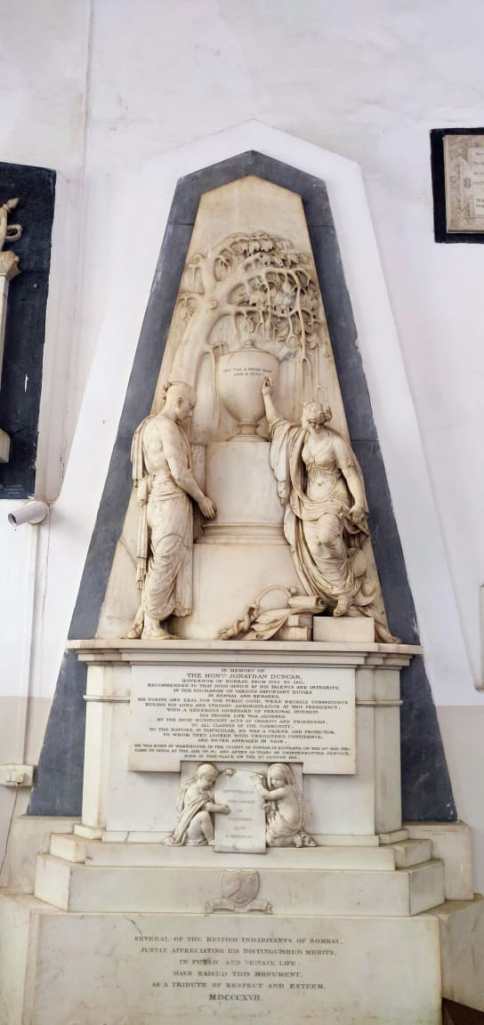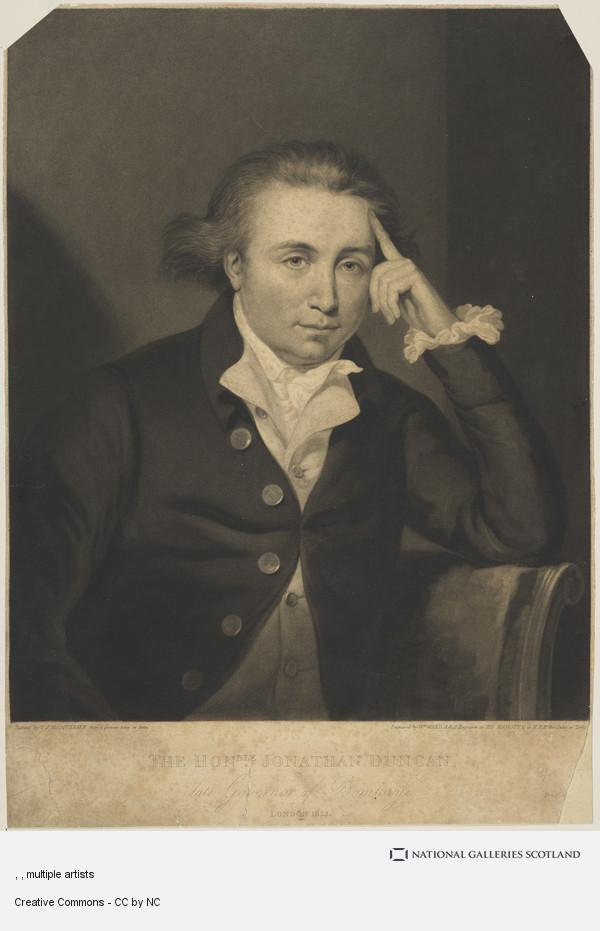Above: The Sanskrit College at Benares established in 1791 by Jonathan Duncan for the study of Hindu law and Philosophy.
The St. Thomas Cathedral in Horniman Circle is the oldest Anglican Church in Mumbai. Inside the Church are many memorials to distinguished Englishmen. Yet, Governor Jonathan Duncan’s memorial stands out. It features a statue of a Hindu Brahmin priest in a meditative mood, under a Holy Banyan Tree.

Now, why would a Hindu priest be represented in a very Christian structure? To answer that, we would have to look into the life of the Honourable Jonathan Duncan.
During the 1700s, when the British East India company was busy tightening its grip on India, there were different kinds of British men in charge. There were many who believed that India existed for profiteering. There were some that believed that Governance was a necessary evil, necessary to earn profits. And then, there were the rare altruists, who believed, that as rulers they must ensure justice and welfare for all citizens. Duncan belonged to this rare breed.
Duncan joined the East India Company in Calcutta in 1772. He was only 16! He was proficient in Dutch, and he became the company’s Dutch translator (the Dutch still did a lot of business in India at that time). Over the years, he handled several responsibilities and moved up the corporate ladder. In 1788, when Governor General Cornwallis, needed a clean administrator to run the Benares kingdom, he promoted the diligent Duncan as the British Resident of Benares, overlooking the claims of more senior candidates.
By now, Duncan had learnt Bengali and Persian and had developed a deep interest in Hindu culture. In Benares, he started studying the Vedas and Sanskrit. He came to believe, that a deeper understanding of Hindu scriptures would help in fair governance. He also believed that it was necessary to preserve and pass on ancient Indian knowledge through systematised education.

Thus, in 1791, Jonathan Duncan established the first Sanskrit College in modern India. The Sampurnanand Sanskrit Vishwavidyalaya in Varanasi is the oldest surviving Sanskrit college in India. It is now a University that is renowned for its library with a treasure trove of ancient Sanskrit manuscripts. And it owes its existence entirely to an Englishman!
But that wasn’t Duncan’s only achievement and not even his greatest. Perhaps his greatest contribution was the abolition female infanticide in Benares. Back then, the community of Rajkumars there, had a tradition of killing new-born female babies. Duncan summoned the community elders and convinced them that it was an unforgivable sin, especially according to Hindu scriptures. The Rajkumars signed a solemn agreement to give up this practice. Duncan realised that moral suasion was far more effective than legal enforcement in the cultural environment of India (Later, the British passed a penal law against infanticide during the leadership of Lord William Bentinck).
Lord Cornwallis was greatly impressed by Duncan’s achievements in Benares. When Cornwallis returned to England, he personally recommended to the Board of Directors that Duncan be made Governor of Bombay. Duncan served with distinction as Bombay’s Governor between 1795 to 1811. He had hoped to leave for England after retirement and even invested in a house in his homeland. But India, refused to let him go. He died in 1811, before he could retire, and was buried in St Thomas Church.
Jonathan Duncan’s memorial in Mumbai, stands as a quiet and beautiful witness to the possibility of harmonious and respectful existence, regardless of personal religious beliefs.
Join Storytrails in Mumbai on ‘The Bombay Story’ walking tour, and discover more stories hidden in plain sight in the Fort Area of Mumbai.
Archives
- January 2022
- December 2021
- November 2021
- August 2021
- March 2021
- February 2021
- January 2021
- December 2020
- November 2020
- October 2020
- September 2020
- August 2020
- April 2020
- March 2020
- February 2020
- January 2020
- November 2019
- October 2019
- September 2019
- August 2019
- July 2019
- June 2019
- August 2017
- February 2017
- January 2017
- October 2013
Featured Posts
- Tales that pots tell: Keeladi excavations AUGUST 18, 2021
- The Last Grand Nawab: Wallajah FEBRUARY 10, 2021
- How Tej Singh became Raja Desingu of Gingee FEBRUARY 5, 2021
- How Shahjahan seized the Mughal throne JANUARY 28, 2021
- Alai Darwaza – Qutub Minar Complex, Delhi NOVEMBER 21, 2020
- Marking History through British buildings NOVEMBER 17, 2020
- The last great queen of Travancore NOVEMBER 7, 2020
- Brahmi and the evolution of scripts OCTOBER 15, 2020
- The Cambodian King of Kanchipuram OCTOBER 14, 2020
- James Prinsep – the man who read the writing on the wall OCTOBER 10, 2020
- Mariamman – the Village Goddess who travelled SEPTEMBER 30, 2020
- Misnamed Monuments of Mamallapuram SEPTEMBER 28, 2020








